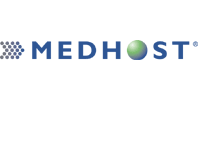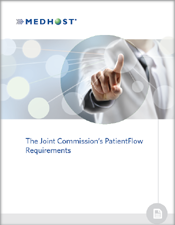Resource:
The Joint Commission's PatientFlow Requirements
MEDHOST’s Patient Throughput Suite can help organizations comply and manage to new JC Requirements addressing patient throughput in the accreditation process.
On December 19, 2012, The Joint Commission released an “R3 Report” that provides the revised hospital standards (LD.04.03.11) for addressing patient throughput in the accreditation process. The requirements, most of which went into effect on January 1st, 2013, also include patient flow tracers to ensure the standards are systematically hardwired throughout the entire hospital.
New functionality within MEDHOST’s Patient Throughput Suite (EDIS, OpCenter and PatientFlow HD) will help organizations effectively comply and manage to these new throughput standards. Listed below is a brief summary of each Element of Performance (EP) for the patient flow standard and examples of how MEDHOST hospitals are managing the standard using EDIS, OpCenter and PatientFlow HD.
EP1: The hospital has processes that support the flow of patients throughout the hospital.
PatientFlow HD allows real-time management of all patient flow processes from the ED through discharge. The Bed Board Visibility view allows bed management to see incoming admissions (transfers, ED admits, direct admits, etc.); current inpatient capacity by house, unit or even bed (including whether the room has been cleaned); and all patients with discharge orders including their discharge location. PatientFlow HD also includes color-coded alerts and automated messages to personnel when a threshold is approached or exceeded. These will lead to a reduction in communication gaps that will ultimately lead to more effective and efficient patient flow.
EP2: The hospital plans for the care of admitted patients who are in temporary bed locations (e.g. ED).
OpCenter allows the hospitals to proactively manage ED bottlenecks, stemmed from ED boarding, through real-time visibility of ED patient flow processes. Using this tool, inpatient bed management and the ED have bi-directional visibility of pending admissions, their service line destination and even bed assignment. PatientFlow HD also features an automated alerting system for patients exceeding acceptable threshold for LOS and other metrics. To ensure care is not delayed, physician orders can also be placed for patients that are holding in the ED.
EP3: The hospital plans for care to patients placed in overflow location.
MEDHOST’s Toolkit (part of OpCenter/ PatientFlow HD) allows immediate modification of nursing units closed/open status. This allows hospitals to utilize PatientFlow HD instantaneously for newly opened overflow areas to flex capacity. PatientFlow HD displays relevant information about special handling needs, length of time in ancillary areas and other relevant information for the care team.
EP4: Criteria guide decisions to initiate ambulance diversion.
OpCenter’s ED Saturation Index uses an algorithm that is inclusive of NEDOCS criteria as well as staffing data points that will also influence the effective capacity of an ED. PatientFlow HD contains real-time and projected capacity by unit/service line. Bed management can easily see if projected capacity exceeds 100% and shift available resources accordingly. The tool can also manage the utilization and location of vital equipment (e.g. telemetry units and ventilators) throughout the hospital and send hospital-wide alerts for diversion status rationale. Also, PatientFlow HD features alert banners, which communicate system-wide messages to all system hospitals. In addition, this functionality can also communicate vital bed status information and guidance to management when diversion (or other statuses such as low ICU beds) exists.
EP5: The hospital measures and sets goals for the components of the patient flow process including:
- The available supply of beds
All beds are proactively managed through PatientFlow HD’s Bed Board Visibility view, which includes all appropriate bed status information. At the hospital level or unit level, color-coding indicates “at-a-glance” what beds are unoccupied. Additionally, the unit managers can indicate preference for Next-Up admissions to insure workload balance of receiving unit.
- Throughput of areas where patients receive care, treatment and services
PatientFlow HD allows organizations to see patient throughput throughout each inpatient and outpatient unit in the hospital. The tool also features functionality to see timers on patient beds that indicate the current location of the patient and how long they have been off the nursing unit, creating awareness for managing and prioritizing patient rounding.
- The safety of areas where patients receive care, treatment and services
PatientFlow HD will take this a step further to ensure that all care providers (regardless of hospital location) are aware of each patient’s needs through special handling icons that designate a specific care protocol (e.g. fall risk, pressure ulcer, core measures, isolation, etc.).
- The efficiency of the nonclinical services that support patient care and treatment
PatientFlow HD uses interactive voice recognition and bed status data (dirty bed, cleaning-in-process, clean bed) to maintain the real-time picture of bed capacity. Seamless communication with EVS allows bed management to direct EVS to priority bed cleanings and minimize unnecessary spot cleans. Admitting staff can utilize the Bed Board view in PatientFlow HD to proactively plan and manage future admissions. The tool also allows organizations to measure critical bed turnover intervals to identify opportunities and take action.
- Access to support services (such as case management and social work)
Through the use of concurrent DRG-coding, PatientFlow HD will automatically assign the DRG-prescribed length of stay (with real-time status updates), core measure identifiers and other valuable case management data. PatientFlow HD also allows clinicians to designate a patient as a “potential discharge” to jump-start discharge planning protocol (including social work) so that when the physician-dictated discharge order is received, the patient is able to leave the hospital sooner. Each patient has a list of assigned care givers so any team member can view all the patients they are caring for and their status in a single view (includes social work, case managers, hospitalists, nurses and techs).
EP6: The hospital measures and sets goals for mitigating and managing the boarding of patients who come through the emergency department.
Through EDIS, patients presenting to the ED with specific criteria (e.g. over 60 years of age and complaining of chest pain) will receive an expedited admission process through BedAhead™.
This process allows clinicians to begin the bed request process for these pre-defined patient criteria, before the actual physician order is given, saving valuable time for this patient and ultimately creating excess capacity in the ED.
PatientFlow HD also features real-time management of inter-hospital goals, which are prompted by alerts. These alerts are triggered when a hospital-designed threshold is exceeded. With PatientFlow HD, hospitals have the ability to constantly tweak thresholds and alert settings within Toolkit to ensure appropriate hospital-wide visibility exists for prioritized metrics.
EP7: The individuals who manage patient flow processes review measurement results to determine whether goals were achieved.
PatientFlow HD also includes robust reporting functionality. All data points used to monitor real-time patient flow are also available historically. Reporting capabilities are available through numerous filters and are easily exportable to Excel. From a financial perspective, PatientFlow HD uses hospital-developed budgetary information to determine real-time and historical variances on metrics such as patient days, case mix index, average length of stay and cost-to-charge ratios.
EP8: Leaders take action to improve patient flow processes when goals are not achieved.
The entire suite of products is geared toward providing leaders with actionable information as it occurs to manage flow. An example is PatientFlow HD’s Financial view, which allows executive leaders the ability to instantly access the viability of hospital-developed patient flow processes. Leaders can see aggregated real-time data on outlier patients (exceeded LOS, exceeded $75k in charges, number of observation patients, etc.) and drill down to identify opportunities by service line, unit or even provider.
PatientFlow HD also features an automated alert functionality, which is triggered when organization-managed thresholds are exceeded. These alerts come in multiple communication vehicles including email, paging and SMS. This allows leaders to set acceptable performance levels and be instantly alerted when these real-time goals are not achieved.
EP9: When the hospital determines that it has a population risk for boarding due to behavioral health emergencies, hospital leaders communicate with behavioral health care providers and/or authorities serving the community to foster coordination of care for this population.
Behavioral health admissions from the ED can be managed as its own service line, visually alerting leaders that they are approaching or have reached an actionable threshold. Alerts can be sent via email to relevant recipients. Once an inpatient status, special handling icons allow for one-touch access to this population to understand LOS, expected discharge and other clinical indications.

